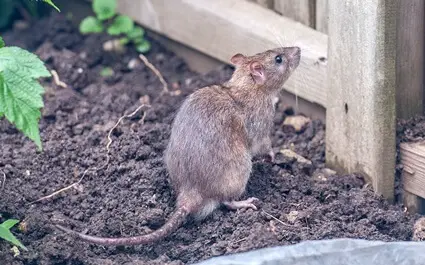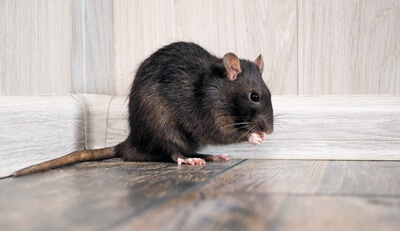Most furry mammals have hair all over their bodies, including their tails. Rats don’t have hairy tails, which may seem rather strange.
Common rats don’t have fur on their tails because they use them for thermal regulation and to grip things when climbing.
Rats don’t sweat, so they expel body heat through their bald tails. Due to the lack of fur, they can expel their body heat through the tail and use it to climb more effectively.
There are many myths surrounding rats’ tails and their lack of hair. However, rats’ tails are hairless due to heat regulation and to climb efficiently.
Why Do Rats Have Bald Tails?
Common rats have bald tails for two main reasons:
- Rats expel heat through their tail to regulate body temperature
- Rats use their hairless tail to grip things when climbing
All animals have different ways of regulating their body temperature to avoid overheating. Unlike humans, rats are incapable of sweating, so they need another way to cool off.
Rats also use their tails to climb, as their paws aren’t always sufficient to get to where they want to go. So, they wrap their tails around anything they can, so they can climb and hang from places.
If their tails were covered in fur, it would be more difficult to do so. However, because the skin of their tails has a grippy texture, they can use it when they need to hang onto something.
How Do Rats Control Their Body Temperature with Their Tails?
Rats control their body temperature with their tail via vasodilation, which refers to the widening of blood vessels.
According to the Canadian Journal of Physiology and Pharmacology, sudden vasodilation occurs between 80.6 and 86 degrees Fahrenheit in rats.
At 86 degrees Fahrenheit, acclimatization occurs, and the rats no longer need vasodilation until 91.4 degrees Fahrenheit.
When a rat’s body temperature rises, the veins and muscular walls surrounding the blood vessels in the rat’s tail relax and widen, allowing more blood to flow through the tail.
The increased blood flow throughout the tail provides the area with more oxygen due to the reduced blood pressure. Once vasodilation occurs, around 20% of the rat’s heat production is lost through the tail.
Vasodilation is an involuntary process that keeps rats from overheating. Rats can’t control the way their tail thermoregulates body heat any more than we can control how much we sweat.
The more the rat’s body temperature rises, the more blood flows through the tail, and the more body heat is expelled through the tail. If you ever touch a rat’s tail and it’s warm to the touch, it’s because its environment is too warm.
Once the temperature goes down, the muscular walls constrict, the blood vessels shrink, and there’s less blood flowing through the rat’s tail. This process is called vasoconstriction.
Because there’s less blood flowing, the tail cools down significantly.
Can a Rat Without a Tail Still Regulate Its Body Heat?
Rats without tails can still regulate their body heat. Besides their tails, rats can expel their body heat through their paws.
Body heat can escape through any part of a rat’s body, including parts covered in fur. However, the fur insulates the rat’s body, so very little heat can escape from those areas. Instead, body heat is expelled through hairless areas like the paws, tail, and ears.
A rat’s tail is its primary thermoregulation organ. Without a tail, a rat will have trouble regulating its body temperature. It’ll be at risk of overheating if it isn’t able to cool itself down with the rest of its body.

Can Rats Live Without a Tail?
Rats can live without a tail.
They can still regulate their body heat without a tail, although their balance and ability to climb will be limited. A tailless rat may have more trouble finding food than other rats.
It’ll have trouble running from danger and climbing certain areas without its tail. As long as the rat has easy access to food, stays out of trouble, and remains cool, being tailless isn’t a major problem.
Are Rats Born with Hair on Their Tails?
Baby rats are born completely bald. They begin to grow hair a few weeks after birth, although it may take several months for their fur to grow fully.
As the rat grows, its tail remains bald at first glance. If you were to look more closely, you’d see that rats have small, fine hairs, although they aren’t very noticeable.
Many people believe that rats are born with hair on their tails but eventually shed it as they grow. This isn’t true, and the confusion might be attributed to people confusing mice and rats.
Mice are smaller than rats, and their tails have fur, albeit short fur. Rats are bigger, and their tails are bald.
What Does a Rat’s Tail Look Like?
Rats’ tails are usually 5-9 inches in length. They’re thick at the base and taper off at the tip.
Their tails are hairless and slender, although not as thin as the tails of mice. The tail’s texture is scaly, like a snake. It has a rough texture, which helps when the rat needs to grip something to climb.
Rats’ tails are usually longer than the rat’s entire body. Although rats can bend their tails to an extent, the tails stay relatively straight.
This is essential when rats run or climb since keeping the tail straight helps them balance.
Can a Rat’s Tail Grow Back?
Rats can’t regrow their tail once they’ve lost them.
Many people think they can because rats can shed their tails just like reptiles do. The fact that rats’ tails are scaly like reptile skin perpetuates this myth.
Rats shed their tails primarily to escape predators and traps. However, unlike reptiles, rodents can’t regrow their tails. Reptiles can because they’re constantly growing by shedding their old skin.
With every molt, they regenerate their body parts, which allows them to regrow missing parts. Rodents are mammals, so they don’t molt and can’t regrow any lost body parts.
Do Rats Have Hair on Their Tails?
Common rats have very thin, small hairs on their tails, but they’re barely noticeable. You would have to get up close to a rat to see any since they’re more like short bristles than hair.
These small hairs help the rats hold onto things and keep their balance.
Other rat species, such as pack rats and kangaroo rats, have noticeable hair on their tails. Even with hairy tails, these rats can use their tails for thermoregulation.
The hair on their tail isn’t as thick as the hair on their body, so it doesn’t limit the heat it can expel.








